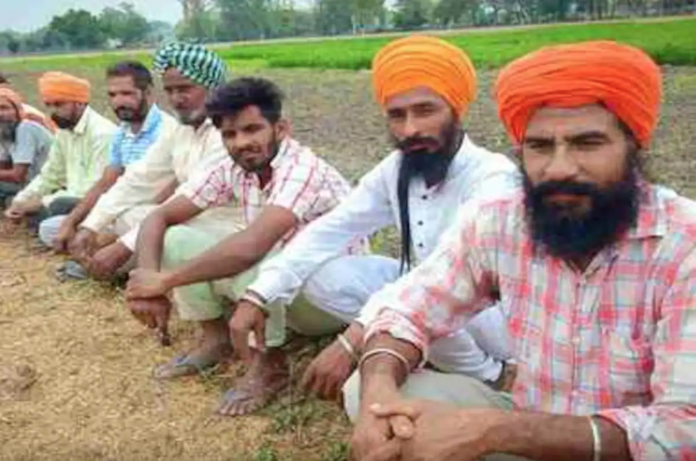With the new Aam Aadmi Party (AAP) government promising to bring reforms, it will be interesting to see how things unfold for Dalit farmers of the state.
Fateh Guram and Rishabh Jain| TwoCircles.net
PUNJAB — Amidst the lush fields of rice and mustard surrounded by ponds and canals in Punjab’s Sangrur district, an area dominated by Dalit Sikhs, a drastic change can be seen with newly constructed houses largely owned by the marginalised community of the area.
This prosperity has been a result of agitation that started in 2014 when the Dalits living in Balad Kalan village of Sangrur district started protesting against the unequal distribution of the land. Their demand was to have one-third of Panchayati land on lease, which later on was accepted by the government. Through protests and agitations, the farmers from the Dalit community in more than 100 villages of Punjab were able to cultivate on land that was legally theirs but was denied to them either by the administration or the upper caste members.
For 63-year-old Charan Singh, a Dalit farmer residing in Balad Kalan, having his own land means a life of self-respect, as it makes him feel secure, both socially and financially.
“Control over our share of common land has ensured that we can grow what we want, and that we can also evenly distribute the crop among ourselves,” he said.
However, despite major reforms in land ownership in Punjab, the Dalit community which constitutes around 32% of the population, owns only 2.3% of the total agricultural land, whereas the Jatt Sikhs who form around 25% of the total population are the major landowners.
Land ownership in Punjab
Dalits in Punjab have two types of land: nazool land for people who moved from Pakistan, and a third of the common land, or panchayat land, as defined by the Village Common Land (Regulation) Act 1961.
The revenue department auctions the common land every year, with representation from the panchayat. The government establishes a rate per acre that is typically 15% higher than the preceding year.
Dalits in Sangrur pushed the administration to amend the auctioning method after a long campaign. The community as a whole, not individuals, is auctioned off the reserved land. A committee makes the bid, and the Dalits share responsibility for the land and harvest — the sond or rainy-season crop, which is primarily rice, and the khari or winter crop, which is primarily wheat.
Avtar Singh, a 35-year-old Dalit farmer from Balad Kalan told TwoCircles.net that earlier when they got the land no one would provide them with loans to spend on input costs for the crop.
“We are 188 families, and all of us pooled money by borrowing it from our relatives. That is how we managed to grow our first ever crop. In three years time, we managed to make profits from the land, and today, we give 5 quintals of wheat to every Dalit household in the village, free of cost,” he said.
Mukesh Malaudh, president of the Zameen Prapati Sangharsh Committee (ZPSC), which fights for the land rights of Dalits believes that having the control of land in the hands of the Dalit farmers has given them a sense of self-respect.
“When the community has land, it has economic power, too. With land comes an entire economy which is dependent on agriculture, and when you have your own land and are not dependent on anyone, it gives you the confidence to stand up to your oppressors,” he said.
Impact of farmer’s protest
When the farmers protest started in the month of November, 2020 the Dalit farmers of Punjab whole heartedly supported it. Although they are not the major landowners, they were still working on the farm lands owned by the Jatt Sikhs of Punjab and they feared they might lose their employment.
However, Mukesh Malaudh believes that despite the Dalits being an integral part of the farmers’ protest, their condition on the ground has not changed a lot.
“The attitudes of upper castes in Punjab have not changed at all after the farmers’ protest. The slogan of Farmer-Worker Unity was a catchy slogan, but it was just that – a catchy slogan. No change has come on the ground,” he said.
He further said that the Dalits in Punjab are not a homogenous group but a heterogeneous one. “Therefore, it becomes difficult to unite them,” he said. He explains this by giving an example that the Ravidasias, for instance, will look down upon the Mazhabi Sikhs. “As a result, it is very difficult to bring different caste groups within the Dalits to a common consensus on a lot of things.”
However, the issue of land is such that people despite their caste differences will come together to fight for it.
“Land has the power to unite people and we also use the struggle for land rights as a means to unite people from across caste lines and divisions,” he adds.
Therefore, keeping the issue of land in mind the ZPSC plans to agitate against the unfairly distributed land in the future. Their aim is to make the Land Ceiling Act to be reduced from 17.5 acres to 10 acres. Now with the new government formation in the state where the Aam Aadmi Party (AAP) promises to bring reforms, it will be interesting to see how things unfold.
Fateh Guram is a Delhi based freelance journalist covering human-rights, caste and communalism. He tweets at @GuramBhaaji. Rishabh Jain is freelance journalist writer based in New Delhi who writes on minorities and society. He tweets at @ThisIsRjain.


